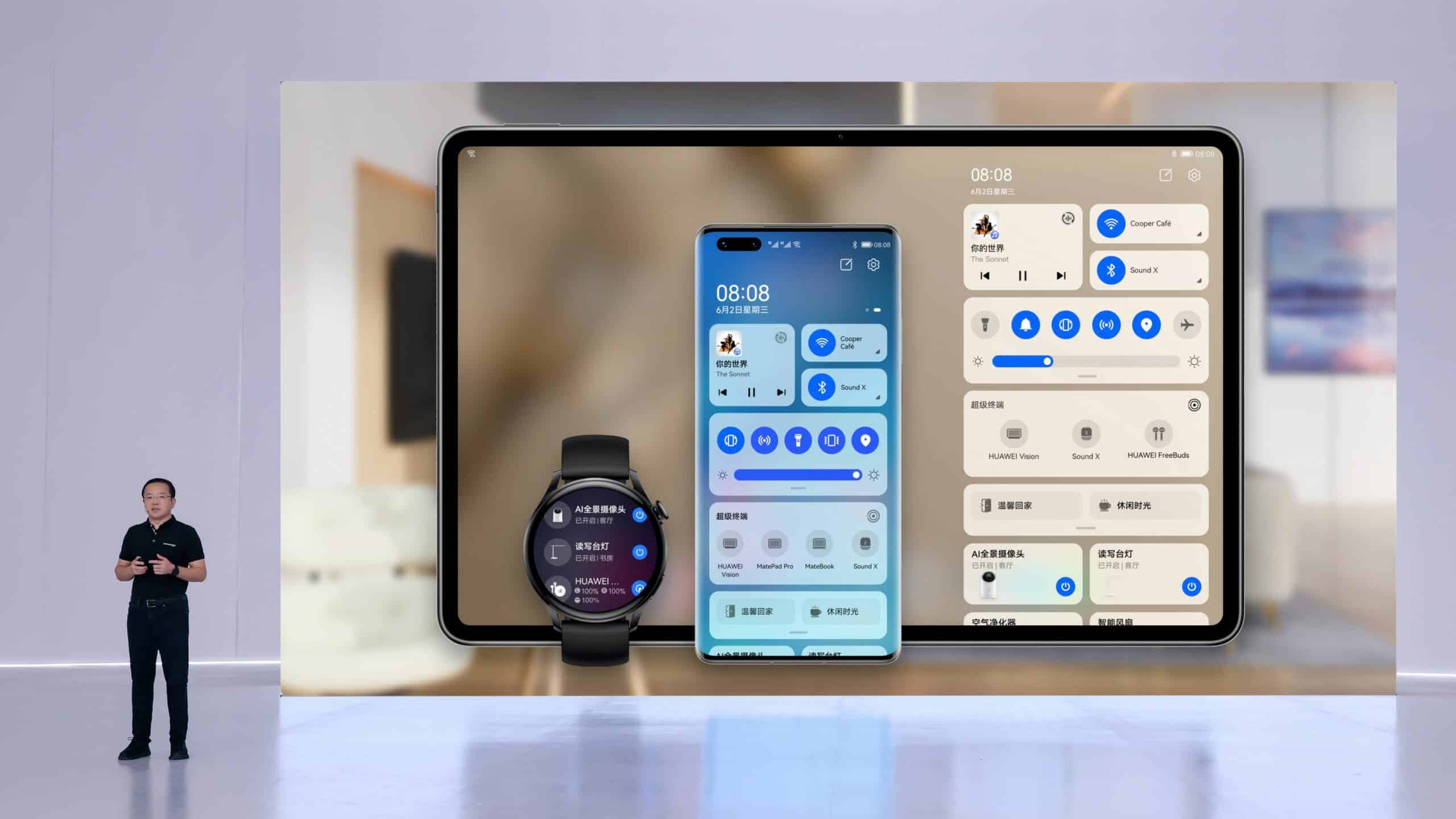The smartphone landscape has long been dominated by two major players: Google’s Android and Apple’s iOS. These operating systems (OS) power billions of devices worldwide, offering users a familiar experience and access to a vast ecosystem of apps and services. However, the recent emergence of Huawei‘s HarmonyOS has thrown a curveball into the established order, raising questions about whether it can disrupt the current market share and become a viable competitor.
Smartphone Operating System Wars: Can HarmonyOS Challenge the Android and iOS Duopoly?

Huawei’s Motivation for HarmonyOS
The story of HarmonyOS is deeply intertwined with the ongoing trade war between the United States and China. In 2019, Huawei was placed on a US entity list, restricting its access to American technology, including Google Mobile Services (GMS), a crucial component of the Android experience. This effectively barred Huawei from using popular Google apps like Gmail, Maps, and Play Store on its smartphones.
Faced with this challenge, Huawei embarked on developing its own operating system, HarmonyOS. This move aimed to achieve two key objectives:
- Reduce dependence on US technology: By creating its own OS, Huawei aimed to lessen its reliance on American companies and mitigate the impact of future trade restrictions.
- Maintain a competitive edge: With access to GMS limited, HarmonyOS offered Huawei a way to continue offering a comprehensive smartphone experience to its users.
HarmonyOS: Features and Functionality
HarmonyOS is designed to be a versatile operating system, functioning across various devices. Including smartphones, smartwatches, smart TVs, and even internet of things (IoT) appliances. It boasts several key features:
- Microkernel architecture: This architecture prioritizes security and efficiency, aiming to provide a robust and reliable foundation for the OS.
- Cross-device connectivity: HarmonyOS seamlessly connects various devices within the same ecosystem, facilitating data sharing and device interaction.
- Multi-device deployment: Developers can create apps that work across different devices powered by HarmonyOS, offering a unified user experience.
Challenges and Opportunities for HarmonyOS
Despite its potential, HarmonyOS faces significant hurdles in its quest to compete with Android and iOS:
- App ecosystem: The lack of established app stores and developer support compared to Android and iOS presents a major challenge. Attracting developers and building a robust app library is crucial for user adoption.
- Market share: Android and iOS hold a dominant market share globally. Making it difficult for a new entrant to gain significant traction.
- Geopolitical factors: The ongoing trade tensions between the US and China could influence the adoption of HarmonyOS outside of China.
However, HarmonyOS also presents several opportunities:
- Focus on privacy and security: With growing concerns about user data privacy, HarmonyOS can leverage its focus on security as a differentiator.
- Integration with the Chinese market: HarmonyOS can potentially cater to the specific needs and preferences of the Chinese market, where it already enjoys a growing presence.
- Open-source approach: Huawei’s decision to partially open-source HarmonyOS could encourage wider adoption and developer collaboration.
Current Landscape and Future Predictions
As of February 2024, HarmonyOS has made inroads primarily in the Chinese market. It powers various Huawei devices, including smartphones, smartwatches, and smart TVs. While it has achieved some success in China, its global presence remains limited.
Analysts offer varying predictions for HarmonyOS’s future. Some believe it has the potential to become a strong player in China. Potentially even surpassing iOS as the second-largest OS in the country. However, achieving global dominance against Android and iOS seems unlikely in the near future.
The Evolving Smartphone Landscape
The emergence of HarmonyOS highlights the dynamic nature of the smartphone operating system landscape. While Android and iOS continue to hold strong positions, new entrants like HarmonyOS demonstrate the potential for disruption. The success of HarmonyOS will depend on its ability to overcome challenges, build a robust app ecosystem, and cater to specific market needs.
Beyond the Duopoly: The Rise of Alternative Operating Systems
While Android and iOS currently dominate the smartphone market, the emergence of HarmonyOS is not an isolated case. Other companies, like Samsung with its Tizen OS, are also exploring alternative operating systems. This trend suggests a potential future where the smartphone landscape is not solely defined by the Android-iOS duopoly, but rather features a more diverse range of options catering to different user needs and preferences.

The Ripple Effects of HarmonyOS: Potential Impacts on the Industry
The potential impact of HarmonyOS extends beyond its direct competition with existing operating systems. Its presence could have broader ramifications for the smartphone industry as a whole:
1. Increased Competition and Innovation: The entry of a new player like HarmonyOS can stimulate competition and innovation within the mobile OS market. This could lead to advancements in features, functionalities, and user experience across all platforms.
2. Diversification of the App Ecosystem: While HarmonyOS currently faces challenges in its app ecosystem, its growth could encourage developers to create apps for multiple platforms, potentially leading to a more diverse and competitive app landscape.
3. Shifting Power Dynamics: The success of HarmonyOS, particularly in specific regions, could alter the power dynamics within the smartphone industry. It could potentially give manufacturers like Huawei more leverage in negotiating with component suppliers and software developers.
4. Geopolitical Implications: The development and adoption of HarmonyOS are heavily influenced by geopolitical factors, particularly the ongoing trade tensions between the US and China. Its success or failure could have wider implications for the global tech landscape and the relationship between these two countries.
5. The Future of Open Source: Huawei’s decision to partially open-source HarmonyOS could contribute to the growth of the open-source software movement within the mobile OS space. This could lead to increased collaboration and innovation within the developer community.
The Role of Consumers in the Smartphone OS Wars
Ultimately, the success of any operating system, including HarmonyOS, hinges on its ability to attract and retain users. Consumers will play a crucial role in shaping the future of the smartphone OS landscape through their choices and preferences.
Here are some factors that could influence consumer decisions:
- App availability: The availability of popular and essential apps on HarmonyOS will be a major deciding factor for many users.
- Device compatibility: The range and quality of devices powered by HarmonyOS will also influence its appeal to consumers.
- User experience: The overall user experience offered by HarmonyOS, including its performance, security, and ease of use, will be critical in attracting and retaining users.
- Brand perception: Huawei’s brand image and reputation, particularly outside of China, could play a role in how consumers perceive HarmonyOS.
Looking Ahead: A More Diverse Smartphone Landscape
The emergence of HarmonyOS, alongside other potential challengers, suggests a future where the smartphone operating system landscape is no longer solely defined by the Android-iOS duopoly. This shift could lead to a more diverse and competitive market. Offering users a wider range of choices and potentially driving innovation across the industry.
However, the success of HarmonyOS and other newcomers remains uncertain. They face significant challenges in overcoming established players, building robust app ecosystems, and navigating complex geopolitical landscapes.
The coming years will be crucial in determining the long-term impact of HarmonyOS and its potential to reshape the landscape of smartphone operating systems. As technology continues to evolve and consumer preferences shift, the battle for dominance in this ever-changing market promises to be an exciting one to watch.

The Evolving Landscape of App Development: Challenges and Opportunities for HarmonyOS
The success of any operating system hinges on its app ecosystem. While HarmonyOS offers several advantages like cross-device compatibility and a focus on security. Attracting developers and building a robust app library remains a major challenge.
Challenges for App Developers:
- Learning a new platform: Developers accustomed to building apps for Android or iOS will need to learn the specifics of HarmonyOS development tools and APIs.
- Limited market reach: Compared to Android and iOS, HarmonyOS currently has a smaller user base, potentially impacting the potential return on investment for developers.
- Uncertainty and risk: The long-term viability of HarmonyOS remains uncertain, making some developers hesitant to invest significant resources in building apps for the platform.
Opportunities for App Developers:
- Early mover advantage: Developers who embrace HarmonyOS early can establish themselves as pioneers in the ecosystem and potentially gain a competitive edge.
- Catering to a specific market: HarmonyOS has the potential to cater to the needs of the Chinese market, offering developers an opportunity to tap into a large and growing user base.
- Open-source collaboration: The partially open-source nature of HarmonyOS could foster collaboration and innovation within the developer community, leading to faster development cycles and improved app quality.
Strategies for Building a Thriving App Ecosystem:
- Focus on essential apps: Prioritizing the development of popular and essential apps like social media, messaging, and productivity tools can attract users and encourage further app development.
- Leverage existing codebases: Tools and frameworks that allow developers to easily port existing Android or iOS apps to HarmonyOS can significantly accelerate app development.
- Incentivize developers: Huawei can offer attractive incentives like financial support, developer tools, and marketing resources to encourage developers to build apps for HarmonyOS.
The Role of Third-Party App Stores:
While Huawei AppGallery is the official app store for HarmonyOS, the presence of third-party app stores could play a crucial role in expanding the app ecosystem. This would provide developers with alternative channels to distribute their apps and reach a wider audience.
Collaboration and Openness: Key to Success
Building a thriving app ecosystem for HarmonyOS requires a collaborative effort from various stakeholders, including Huawei, developers, and third-party app stores. Openness, transparency, and providing developers with the necessary tools and resources will be crucial in attracting talent and fostering a vibrant app development community.
The Long-Term Outlook: Can HarmonyOS Disrupt the Market?
Predicting the long-term success of HarmonyOS is challenging. While it has the potential to become a significant player in the Chinese market. Achieving global dominance against established giants like Android and iOS seems unlikely in the near future.
Factors Influencing HarmonyOS’s Future:
- App ecosystem development: The pace and success of building a robust app library will be critical in attracting users and developers to the platform.
- Geopolitical landscape: Ongoing trade tensions and international relations could impact the adoption of HarmonyOS outside of China.
- Consumer perception: User experience, device compatibility, and brand image will play a crucial role in shaping consumer preference for HarmonyOS.
- Innovation and differentiation: HarmonyOS’s ability to offer unique features and functionalities that cater to specific user needs will be essential for standing out in the crowded market.
A More Diverse Future for Mobile OS Landscape
Regardless of HarmonyOS’s ultimate success, its emergence highlights the potential for a more diverse and competitive mobile operating system landscape. This shift could benefit users by offering them a wider range of choices, fostering innovation across the industry, and potentially challenging the dominance of existing players.

Beyond Smartphones: HarmonyOS and the Broader Tech Ecosystem
While the primary focus of this discussion has been on HarmonyOS’s potential to disrupt the smartphone operating system landscape, its impact could extend beyond this realm. Huawei envisions HarmonyOS as a versatile platform powering various devices and appliances, creating a seamlessly connected ecosystem.
HarmonyOS and the Internet of Things (IoT):
HarmonyOS’s ability to connect and manage various devices within a single ecosystem positions it well for the growing IoT market. This could lead to:
- Simplified device management: Users can control and interact with various smart devices, from thermostats and lighting to wearables and appliances, through a unified interface.
- Enhanced interoperability: Devices powered by HarmonyOS can seamlessly communicate and share data. Enabling more automated and intelligent functionality within the smart home environment.
- Increased security: The focus on security within HarmonyOS can contribute to a more secure and reliable foundation for the interconnected IoT landscape.
Challenges and Opportunities in the IoT Space:
- Standardization and compatibility: HarmonyOS needs to ensure compatibility with existing IoT standards and protocols to truly thrive in this space.
- Competition from established players: Existing players like Apple’s HomeKit and Google’s Home Assistant already have a strong presence in the smart home market.
- Data privacy concerns: As the number of connected devices grows, concerns about user data privacy and security within the HarmonyOS ecosystem need to be effectively addressed.
HarmonyOS and Artificial Intelligence (AI):
The integration of AI capabilities within HarmonyOS can unlock new possibilities for personalized user experiences and intelligent device interactions. This could involve:
- Context-aware features: Devices can learn user preferences and adapt their behavior accordingly, offering a more personalized and intuitive experience.
- Proactive assistance: AI-powered features can anticipate user needs and proactively offer assistance. Such as adjusting lighting or temperature based on user presence or activity.
- Enhanced security: AI can be used to detect and prevent potential security threats within the interconnected ecosystem.
Challenges and Opportunities in AI Integration:
- Ethical considerations: The development and deployment of AI within HarmonyOS need to adhere to ethical guidelines and ensure responsible use of user data.
- Computational resources: Integrating advanced AI capabilities might require additional processing power and resources, which could pose challenges for certain devices.
- Transparency and explainability: Users need to understand how AI algorithms are used within HarmonyOS and be able to control the level of automation and personalization.
The Future of the Connected Ecosystem:
HarmonyOS’s potential to connect and manage various devices across different categories presents both challenges and opportunities in the broader tech ecosystem. Its success will depend on its ability to overcome these challenges, foster collaboration with industry players, and address user concerns regarding privacy, security, and ethical considerations.
Conclusion:
The emergence of HarmonyOS marks a significant development in the tech landscape. Not just for smartphones but also for the broader ecosystem of connected devices and AI integration. While its long-term impact remains uncertain, it has the potential to contribute to a more diverse and interconnected tech environment, offering both new possibilities and challenges that need to be carefully navigated. As technology continues to evolve and user needs change, the future of HarmonyOS and its role within the ever-expanding tech ecosystem will be an interesting story to follow.





